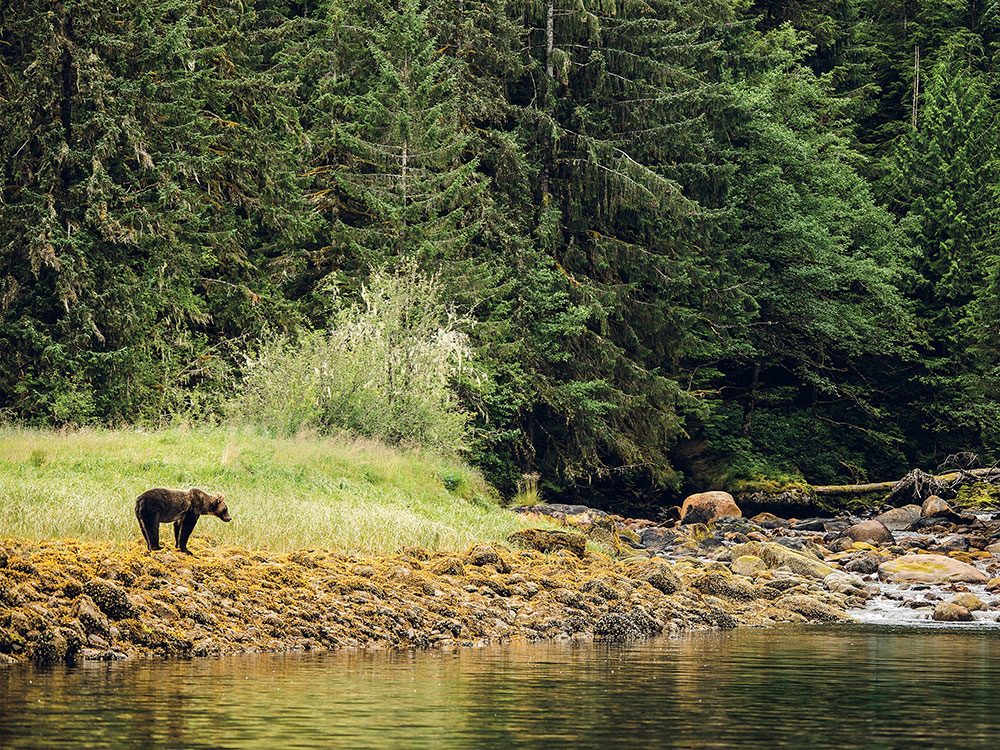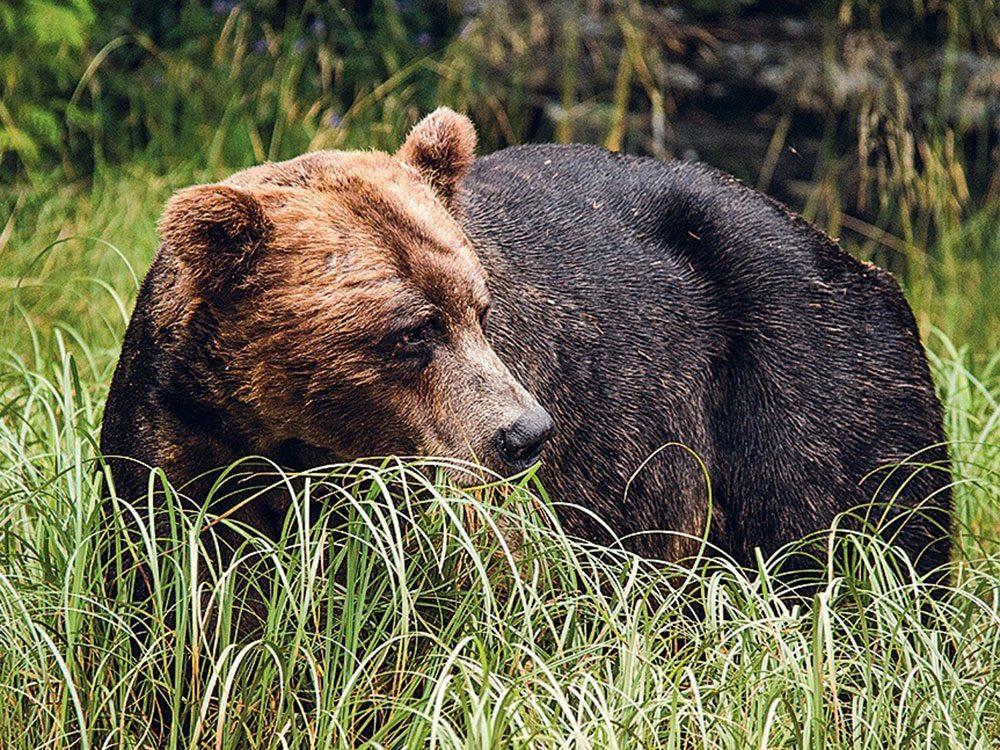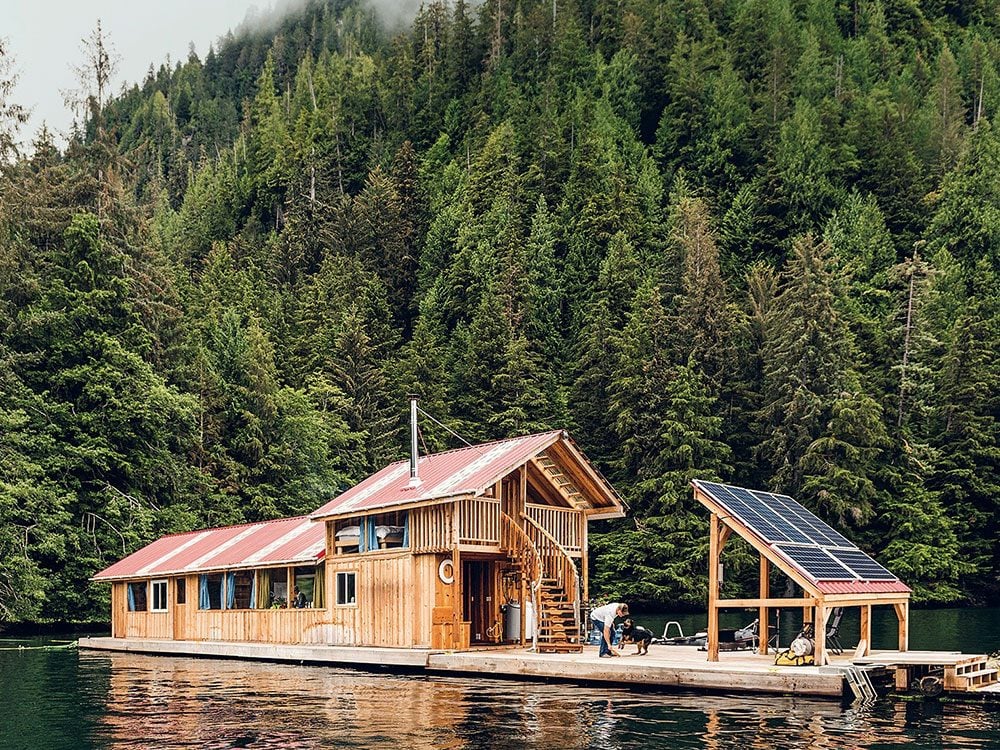
Inside B.C.’s grizzly sanctuary
“Remember, you don’t have to run faster than the bear,” our bush pilot, Ken Cote, informs us. “You just have to run faster than one of us.” I look at our eight-member group appraisingly, and my eyes linger on Tyler Clarke, a staffer from Northern BC Tourism who is wearing the 18-kilogram Google Street View Trekker backpack. I exhale ever so slightly.
When in grizzly country, it’s inevitable that someone will drop a zinger about bears—it’s just a question of when. For us, it happened on the dock at the floating Khutzeymateen Wilderness Lodge, five minutes after hopping off Cote’s de Havilland Beaver float plane. Joking about hungry wildlife may be good fun in campsites across Canada, but up here, 50 kilometres north of already-remote Prince Rupert, B.C., Cote’s advice takes on a morbid practicality.
Aside from the lodge’s staff, the members of our troop—which includes a Swiss family (two parents, three kids)—are the only human occupants of the Khutzeymateen Grizzly Bear Sanctuary and adjacent conservancies. The 58,360 hectares of protected habitat is home to roughly 50 grizzlies, so we’re seriously outnumbered. But for us, that’s a good thing, as the Trekker has been dispatched here for the sole purpose of seeing these giants in their natural setting and cataloguing the experience for Google-able posterity. The only problem is, we can’t seem to find them.
Check out these remarkably photogenic animals in their natural habitats.

Mapping the bears
An afternoon trip with lodge owner Jamie Hahn aboard his work horse Zodiac takes us deep into the inlet, right to the mouth of the Khutzeymateen River. We pass towering cliffs and a half-dozen waterfalls, but our lone grizzly sighting consists of a passing glance at a small juvenile bear nicknamed Big Ears; he bolts from the shore back into the dense brush as soon as we manoeuvre our craft a little closer. Hahn scratches his head and mutters: “We saw 11 bears around here three days ago.”
We chug back to camp for an early dinner, where Manuela, the lodge’s chef, has whipped up a consolation feast of roast chicken and rösti. Afterward, there’s talk of fishing (on a floating lodge, you can drop a line pretty well anywhere), but given that the sun won’t set until 10 p.m., we decide to head back out to further explore the pristine scenery and one of the falls we passed earlier. Getting off the boat within the sanctuary is verboten, but the lodge sits outside its borders, where a brief on-land reverie is possible in a few spots.
A damp moss carpets everything and requires careful footing; with the Trekker in tow, it means that slow going is the order of the day. After 15 minutes of plodding, one of life’s fundamental truths—that there’s no such thing as a bad waterfall—is proven again when we’re rewarded with the view of water tumbling down a steep mountainside studded with ancient cedars. The scene feels very go-with-the-flow, but you can only bliss out for so long when you’re following a path blazed not by humans but by our evasive four-legged friends.
Thanks to the joint effort by Google and Destination British Columbia (the province’s tourism board), virtual visitors will get a similar experience—no bear repellent necessary. Just as you can use Google Street View to explore the neighbourhood you grew up in, you’ll soon be able to get a 360-degree sense of the Khutzeymateen and other remote locales. My initial worry, that clickable access to difficult terrain will further turn us into a nation of couch potatoes, is quickly dismissed. It’s more likely that when these images, captured by 15 whirring lenses, are seen, adventurous travellers will be lining up to experience first-hand the cool breeze that comes off the plunge pool.
Don’t miss this inspiring story about the man who lived with bears.

Hello, Big Ears
“Can grizzlies swim?” It’s the next morning and we’re back on the boat when one of the young Swiss boys pipes up in a tone of trepidation mixed with excitement. All eyes dart starboard, to a slow-moving head gliding across the channel, and Hahn cuts the engine. We watch the head as it makes for shore, and it turns out to indeed be attached to a 300-kilogram Ursus arctos horribilis.
Unlike Big Ears, this laid-back fella has zero worries about us—or anything else, for that matter. As he lumbers along the beach, less than 10 metres from the boat, his seven-centimetre-long claws click-clacking over the rocks, his air of indifference is impressive, if a little galling. For him, we might be indistinguishable from the flies circling nearby. On the other hand,we’re in awe and snap picture after picture on our cameras, which will pale in comparison to those of the Trekker. With a subtle hum, it captures the event in dozens of unique frames per minute. At times we’re so close we can hear the grizzly’s heavy breathing, and the Swiss family, who’ve travelled halfway around the globe for this moment, can’t stop smiling.
We follow our subject for another half-hour, and he never gives us so much as a backwards glance. He drops into the water here and there and at one point pokes around in a stream, angling for a snack. The bear’s laissez-faire attitude seems to signal his self-assurance: there’s no doubt about who owns this environment.
Then, just like that, the grizzly is gone—darting up a steep mountainside, swallowed by the wilderness. Once again, the inlet is deserted and we return to the dock, silent. Each year, thousands of people make it up here to see these giants, but as of last year, any one of Google Maps’ billion monthly users has been able to log on and check out what we saw—though you should really make the trek to come see it for yourself.
A Bed on the water: The floating Khutzeymateen Wilderness Lodge, which has six bedrooms, shared living and dining areas, and a sauna, offers one- and four-day tours to the secluded North Coast inlet—a popular area for the sanctuary’s grizzly population—from May 1 to September 15.
Discover the nine animals you can find in Prince Albert National Park.
© 2017 by Neal McLennan. Air Canada’s enRoute (July 2017). enroute.aircanada.com